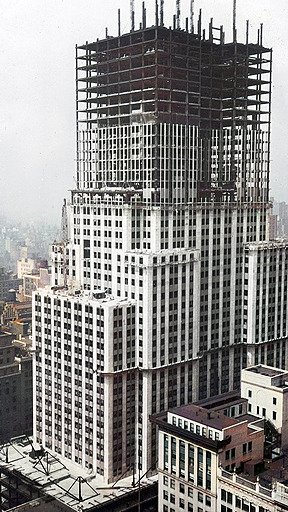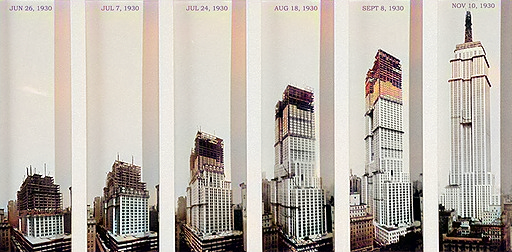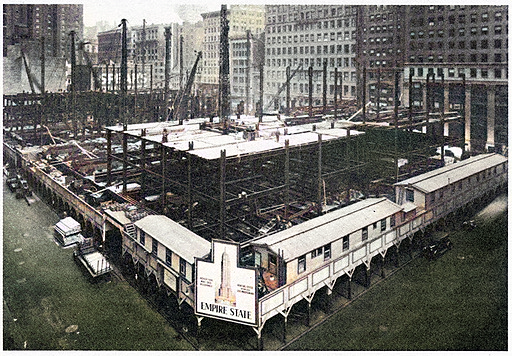New York City, a metropolis renowned for its towering skyscrapers and architectural innovation, is home to one of the most iconic buildings in the world—the Empire State Building. Rising above the city with an awe-inspiring stature, this monument of human ambition and architectural prowess has a rich history and intriguing facts that contribute to its legendary status.
Constructed during the Great Depression, the Empire State Building emerged as a symbol of hope, resilience, and human achievement in an era marred by economic struggle. With its completion in 1931, it instantly captured the imagination of people worldwide, standing as the tallest building on the planet for nearly four decades. The Empire State Building is more than just a monument—it’s a testament to innovative construction and design techniques that forever changed the world of architecture.

From its foundations deeply rooted in Manhattan schist to the shining aluminum spire that graces the New York City skyline, every facet of the Empire State Building is steeped in fascinating details. Behind its limestone and granite façade lies a structural skeleton of high-strength steel, meticulously designed to withstand both gravity and the fierce winds that buffet skyscrapers of such colossal heights. The building is a feat of engineering and a treasure trove of technical insights, providing countless lessons in construction and design.

In the following article, we delve into the top-100 construction and design facts of the Empire State Building. Each point will unravel the secrets behind this monument’s design, from its robust foundation, the equivalent strength of its superstructure, to the intricate details about the loading on the structure. We’ll look into the types of materials used and explore fun facts about the materials’ origin and application.
We’ll walk you through the journey from the blueprints of William F. Lamb and his team at Shreve, Lamb & Harmon, to the fruition of a structure that embodies the relentless spirit of New York. The Empire State Building is not merely built; it’s crafted with attention to every detail. Every steel beam, rivet, and concrete slab tells a story of an era and the visionary minds that dared to dream big.
Furthermore, we will delve into the specific codes used for the design, explaining why certain standards were adhered to and how they ensured the building’s long-term safety and stability. Additionally, we’ll examine the grades of concrete and steel used in its construction and their implications on the building’s overall strength and durability.
Moreover, we’ll discuss the economic analysis of the structure, shedding light on the initial cost, the Great Depression’s impact, and how it eventually became a profitable venture, contributing significantly to New York City’s economy. The life span of such a monumental structure and the factors contributing to its longevity will also be discussed in detail.
Another exciting area we’ll explore is the geological aspect of the building site. Understanding the role that the soil and bedrock at the site played in supporting such a massive structure provides insightful knowledge into the art of constructing skyscrapers.

Finally, we will touch upon the technical data that outlines the building’s remarkable features. This includes the dynamic loading details that delve into how the Empire State Building stands firm against environmental factors like wind and earthquakes.
Top-100 Facts of Empire State Building
- The Empire State Building was constructed at the total cost of about $40.9 million (around $550 million in today’s dollars).
- Its foundation is a massive concrete raft, designed to distribute the building’s weight evenly.
- The foundation extends 55 feet (16.8 meters) below ground level.
- The superstructure consists of a steel frame that supports the building’s weight and resists wind forces.
- The building was designed by William F. Lamb from the architectural firm Shreve, Lamb & Harmon.
- The Empire State Building was designed to support a dead load of approximately 150,000 tons.
- The structure is primarily composed of steel, limestone, granite, and aluminum.
- The building’s strength is equivalent to that of a structure made with 60,000 tons of steel.
- The design was based on the 1927 edition of the Uniform Building Code.
- High-strength A572 grade 50 steel was used in the construction, while the concrete strength varies throughout, with a maximum of about 6000 psi.
- In economic terms, the Empire State Building was initially not profitable due to the Great Depression, but it later became a major moneymaker and a symbol of American industry.
- With good maintenance, the building’s life span is indefinite, still going strong as of 2023.
- The bedrock at the site is Manhattan schist, a solid base that is ideal for supporting large structures.
- The building stands at 1,454 feet (443.2 meters) including its antenna, and has 103 floors.
- It was designed to resist wind loads up to 200 miles per hour.
- The Empire State Building was the world’s tallest building until 1970 when the North Tower of the World Trade Center was completed.
- It took just one year and 45 days to construct this architectural marvel.
- About 3,400 workers were involved in its construction.
- The building weighs approximately 365,000 tons.
- The base of the Empire State Building is approximately 2 acres.
- It was opened to the public on May 1, 1931.
- Over 10 million bricks were used in the construction.
- It was the first building to have more than 100 floors.
- The spire was originally designed to be a mooring mast for airships.
- Aluminum was extensively used in the Empire State Building’s construction, including in its famous spire.
- The Empire State Building has its own ZIP code: 10118.
- Despite initial unprofitability, it became profitable in the 1950s.
- An economic analysis of the building’s profitability indicates it has been a wise investment over time.
- On a clear day, you can see five states from the Empire State Building’s observatories: New Jersey, Pennsylvania, Connecticut, Massachusetts, and Delaware.
- The building is equipped with its own water treatment system, enabling it to be self-sufficient.
- The Empire State Building went through a $550 million renovation in 2010 to make it more energy-efficient.
- Its steel frame was prefabricated and then brought to the site, allowing for a rapid construction process.
- It’s said that during construction, the framework went up at a rate of 4.5 stories per week.
- 58,000 tons of steel, 200,000 cubic feet of Indiana limestone and granite, 10 million bricks, and 730 tons of aluminum and stainless steel were used to build the Empire State Building.
- The Empire State Building has 6,500 windows.
- An estimated 50 tons of dirt and debris was removed daily during construction.
- The observation decks attract around 4 million visitors each year.
- The original name was to be “The Fifth Avenue Building.”
- The building uses its own type of LED lights to light up in celebration of various events and holidays.
- It has its own art deco lobby and murals, which were restored in 2009.
- Its height, including the antenna, is 1,454 feet (443.2 meters).
- The building’s lightning rod is struck by lightning around 23 times a year.
- The Empire State Building has 73 elevators, including service elevators.
- The elevator speed is 1,200 feet per minute.
- The building has been featured in over 250 films.
- The Empire State Building was the site of a tragic B-25 bomber crash in 1945.
- It was designated a National Historic Landmark in 1986.
- It is also an American Society of Civil Engineers Landmark.
- It was named “America’s favorite building” in a poll conducted by the American Institute of Architects.
- The Building was the first building to use an automated ticketing system.
- It consumes approximately the same amount of energy as 40,000 single-family homes annually.
- There are 1,860 steps from street level to the 102nd floor.
- The mast at the top of the Empire State Building is used to broadcast many TV and radio stations in the New York metropolitan area.
- In 2012, it was ranked as the #1 tallest LEED-certified building.
- Each year, a race is held where people from around the world participate in a run up the stairs to the 86th floor.
- The Building houses approximately 1,000 businesses and has its own police unit.
- The base of the Building is clad in limestone and granite, whereas the interior is lined with marble and aluminum.
- The Empire State Building’s design was influenced by the Art Deco style, characterized by its geometric forms and simple, clean lines.
- It was designed to be fireproof, with steel columns and beams covered in a layer of concrete for protection.
- Each year, the Empire State Building hosts a Valentine’s Day event where couples can get married on the 80th floor.
- The foundation of the building was completed in record time — only 50 days.
- The construction project was completed ahead of schedule and under budget.
- The Empire State Building has 70 miles of pipe, 2.5 million feet of electrical wire, and about 560 miles of telephone wire.
- The Empire State Building is recognized as an icon of New York City and the United States.
- During construction, despite the extreme height and speed of construction, only five workers died – which is considered low for a project of this scale at that time.
- It was the first building to employ the fast-track construction technique, where design and construction processes overlap.
- Over 7 million man-hours were expended during the construction of the Empire State Building.
- Despite its size, the Empire State Building has an excellent safety record, with very few serious incidents.
- A giant ape, King Kong, famously scaled the building in the 1933 movie and its remakes.
- To this day, the Empire State Building remains an enduring symbol of human achievement and ambition.
- The building’s electrical system is so extensive that it has its own power plant.
- The steel columns and beams of the Empire State Building were erected at a rate of 4.5 stories per week.
- The Empire StateBuilding was one of the first major building projects to use a computer for project management.
- It has more office space than any other building in New York City, around 2.7 million square feet.
- The Empire State Building holds annual light shows for Christmas and New Year’s Eve.
- The construction project used hot rivets, a technique no longer used in today’s building techniques.
- It is the centerpiece of an impressive skyline, a status it has held for over nine decades.
- It uses a state-of-the-art building management system to control its mechanical and electrical systems.
- The observatory on the 86th floor offers a 360-degree view of New York City.
- In 1945, a 10,000-pound bomber crashed into the Empire State Building’s 79th floor due to fog.
- On the 86th floor, there is an outdoor deck that encircles the building.
- The top floor of the Empire State Building is home to many broadcast antennas, making it a key site for radio and television transmission.
- The Empire State Building’s stainless steel pinnacle is a lightning rod for the structure, and it is struck by lightning approximately 23 times each year.
- The building is anchored in Manhattan schist, a bedrock that provides stability.
- An estimated 1,575,100 rivets were used in the Empire State Building’s construction.
- The Empire State Building sways a few inches in the wind to absorb its energy.
- The building contains 473 miles of electrical wiring and 70 miles of pipe.
- To clean its windows, the Empire State Building uses a unique window-washing rig.
- It was named after New York’s state nickname, the “Empire State.”
- It stands as a testament to American engineering and architectural prowess.
- Despite its height, the Empire State Building only has a single basement level.
- The steel used in the building was produced by the Carnegie Steel Company, a division of U.S. Steel.
- The aluminum spire was added at the last minute to beat the Chrysler Building for the title of world’s tallest building.
- It was officially dedicated by U.S. President Herbert Hoover on May 1, 1931.
- To ensure safety, construction workers were required to wear safety harnesses and nets were installed to catch falling debris.
- It has a total of 6,514 windows.
- A typical floor in the Empire State Building has about 210 office spaces.
- In 1964, floodlights were added to illuminate the top of the building at night.
- It was once used for zeppelin dockings at its spire; however, high winds made this impractical.
- The Empire State Building’s observatories generate more revenue than its office spaces.

FAQ’s
How long did it take to build the Empire State Building?
The Empire State Building was built in an impressively short time for a building of its size. The construction began on March 17, 1930, and the building officially opened just over a year later, on May 1, 1931. This rapid completion time was a result of efficient planning, coordination, and the work of thousands of construction workers.
What materials were used in the construction of the Empire State Building?
The primary material used in the construction of the Empire State Building was steel, making up the building’s internal skeleton. The façade of the building was composed of Indiana limestone and granite, with the building’s distinctive spire made from aluminum.
What is the Empire State Building’s foundation made of ?
The foundation of the Empire State Building is made of concrete footings supported by layers of compacted soil and Manhattan bedrock known as Manhattan schist, which is capable of supporting the tremendous load of the building.
Who was the architect of the Empire State Building?
The Empire State Building was designed by William F. Lamb from the architectural firm Shreve, Lamb & Harmon. His design was completed in just two weeks.
What type of design was used for the Empire State Building ?
The design of the Empire State Building is in the Art Deco style, a popular architectural style in the 1920s and 1930s characterized by its use of symmetry, geometric designs, and simple, clean shapes.
What was the cost of building the Empire State Building ?
The total cost of constructing the Empire State Building was approximately $40.9 million in 1931, equivalent to about $563 million in today’s dollars. This includes the cost of land acquisition, design, construction, and interior fittings.
What is the height of the Empire State Building?
The height of the Empire State Building, including its antenna, is 1,454 feet (443.2 meters). Without the antenna, the building itself stands 1,250 feet (381 meters) tall.
What kind of steel was used in the Empire State Building?
The Empire State Building’s construction utilized a high-strength, carbon alloy steel. The steel was supplied by the Carnegie Steel Company, a division of U.S. Steel.
How many floors does the Empire State Building have?
The Empire State Building has a total of 102 floors. These include 85 floors of commercial and office space, an observatory on the 86th floor, and additional floors up to the 102nd floor that are part of the building’s pinnacle.
What makes the Empire State Building withstand high winds and earthquakes?
The Empire State Building can withstand high winds and minor earthquakes due to its robust steel frame design. The steel framework acts as a rigid cage, distributing the forces evenly throughout the structure. Furthermore, the building was designed with a factor of safety, which means it was built to handle stresses far greater than it would typically experience.
Read More


1 thought on “Empire State Building : Top-100 Construction and Design Facts”